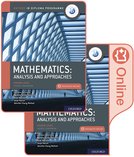Oxford IB Diploma Programme: IB Mathematics: analysis and approaches, Higher Level, Print and Enhanced Online Course Book Pack
Author Marlene Torres Skoumal, Author Rose Harrison, Author Josip Harcet, Author Jennifer Chang Wathall, and Author Lorraine Heinrichs
Price: £72.99
+VAT
ISBN:
978-0-19-842716-2
Publication date:
21/03/2019
Pack:
832 pages
Dimensions:
255x195mm
Availability: In stock.

Digital Evaluation
Schools can access an online copy of the whole book free of charge for 30 days. At the end of the evaluation period, you can buy printed copies here or through your usual sales consultant or bookseller.
Free Trial
Register your school for a free trial of the digital subscription. For more information contact your local educational consultant.
You can use the basket to:
- pay by credit card
- order on account
- forward to a colleague
Description
Features
- Address all aspects of the new DP Mathematics: analysis and approaches HL syllabus via an Enhanced Online Course Book Pack - made up of one full-colour, print textbook and one online textbook, including extensive teacher notes
- Ensure learners are ready to tackle each topic with targeted 'Prior Knowledge' worksheets, linked to 'Before You Start' summaries and exercises at the start of every chapter
- Deliver in-depth coverage of all topics through clear explanations and worked solutions, animated worked examples, differentiated exercises and worksheets, with answers provided
- Adopt a concept-based approach with conceptual lenses and microconcepts woven into every chapter, plus rich investigations that integrate factual and conceptual questions - leading to meaningful, content-specific conceptual understanding
- Deepen mathematical understanding via inquiry-based tasks that relate to the content of each chapter, 'international mindedness' features, regular links to Theory of Knowledge, and activities that target ATL skills
- Support students' development of a mathematical toolkit, as required by the new syllabus, with modelling and investigation activities presented in each chapter, including prompts for reflection, and suggestions for further study
- Thoroughly prepare students for IB assessment via in-depth coverage of course content, overviews of all requirements, exam-style practice questions and papers, and a full chapter supporting the new mathematical exploration (IA)
- Includes support for the most popular Graphic Display Calculator models
- This Online Course Book will be available on Oxford Education Bookshelf until 2029. Access is facilitated via a unique code, which is sent in the mail. The code must be linked to an email address, creating a user account.
- Access may be transferred once to a new user, once the initial user no longer requires access. You will need to contact your local Educational Consultant to arrange this.
This page was last updated on 22 December 2024 at 20:30 GMT
Table of Contents
From patterns to generalizations: sequences and series
1.1: Sequences, series and sigma notation
1.2: Arithmetic and geometric sequences and series
1.3: Proof
1.4: Counting principles and the binomial theorem
Representing relationships: introducing functions
2.1: Functional relationships
2.2: Special functions and their graphs
2.3: Classification of functions
2.4: Operations with functions
2.5: Function transformations
Expanding the number system: complex numbers
3.1: Quadratic equations and inequalities
3.2: Complex numbers
3.3: Polynomial equations and inequalities
3.4: The fundamental theorem of algebra
3.5: Solving equations and inequalities
3.6: Solving systems of linear equations
Measuring change: differentiation
4.1: Limits, continuity and convergence
4.2: The derivative of a function
4.3: Differentiation rules
4.4: Graphical interpretation of the derivatives
4.5: Applications of differential calculus
4.6: Implicit differentiation and related rates
Analysing data and quantifying randomness: statistics and probability
5.1: Sampling
5.2: Descriptive statistics
5.3: The justification of statistical techniques
5.4: Correlation, causation and linear regression
Relationships in space: geometry and trigonometry
6.1: The properties of 3D space
6.2: Angles of measure
6.3: Ratios and identities
6.4: Trigonometric functions
6.5: Trigonometric equations
Generalizing relationships: exponents, logarithms and integration
7.1: Integration as antidifferentiation and definite integrals
7.2: Exponents and logarithms
7.3: Derivatives of exponential and logarithmic functions; tangents and normals
7.4: Integration techniques
Modelling changes: more calculus
8.1: Areas and volumes
8.2: Kinematics
8.3: Ordinary differential equations (ODEs)
8.4: Limits revisited
Modelling 3D space: vectors
9.1: Geometrical representation of vectors
9.2: Introduction to vector algebra
9.3: Scalar product and its properties
9.4: Vector equations of a line
9.5: Vector product and properties
9.6: Vector equation of a plane
9.7: Lines, planes and angles
9.8: Application of vectors
Equivalent systems of representation: more complex numbers
10.1: Forms of a complex number
10.2: Operations with complex numbers in polar form
10.3: Powers and roots of complex numbers in polar form
Valid comparisons and informed decisions: probability distributions
11.1: Axiomatic probability systems
11.2: Probability distributions
11.3: Continuous random variables
11.4: Binomial distribution
11.5: The normal distribution
Exploration
© 2024 Oxford University Press. All rights reserved.






